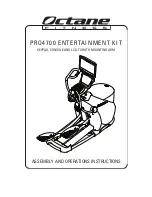
Global P6: Arpeggio Pattern Other examples of creating a user arpeggio pattern
247
Tone00–09:
0–9 switches
Tone10:
– switch
Tone11:
. switch
Creating an example pattern
1. Set “Step No.” to 01, and press the [0] key.
2. Set “Step No.” to 02, and press the [1] key.
3. Set “Step No.” to 03, and press the [2] key.
4. Set “Step No.” to 04, and press the [1] key.
5. Set “Step No.” to 05, and press the [3] key.
6. Set “Step No.” to 06, and press the [1] key.
7. Set “Step No.” to 07, and press the [2] key.
8. Set “Step No.” to 08, and press the [1] key.
9. When you play the keyboard as shown in the illustra-
tion, the arpeggiator will begin playing.
Tone 0 corresponds to the pitch of the lowest key of chord
you play on the keyboard. (If
Sort
is unchecked, it will
correspond to the pitch of the first note you play.)
10. For steps 01–08, make settings for “Pitch Offset,”
“Gate,” “Velocity,” and “Flam.”
Pitch Offset:
This offsets the pitch of the arpeggio note in
semitones up or down. You can input the same tone for each
step, and change the
Pitch Offset
value for each to create a
melody using a single tone. (See “Melody pattern”)
Gate:
Specifies the length of the arpeggio note for each step.
With a setting of Legato, the note will continue sounding
either until the next note of the same tone or until the end of
the pattern. With a setting of Off, the note will not sound.
Velocity:
Specifies the strength of the note. With a setting of
Key, the note will sound at the strength with which it was
actually played.
The
Gate
and
Velocity
settings you make here will be
valid if the
Gate
and
Velocity
parameters (Program P7:
ARP/DT– ARP Setup page) of the program selected in
Program mode are set to Step. If these parameters have
a setting other than Step, the
Gate
and
Velocity
that
were specified for each individual step will be ignored,
and all notes of the arpeggio will sound according to
the settings in Program P7: ARP/DT– ARP Setup page.
Be sure to verify the settings of the program.
When specifying
Gate
and
Velocity
, press the control
surface ARP switch, and set knob 1 (GATE) and knob 2
(VELOCITY) to the center position (12 o’clock).
11. To change the user arpeggio pattern name, use the
“Rename Arpeggio Pattern” menu command. (See
page 255)
12. If you wish to save the edited user arpeggio pattern to
internal memory, be sure to Write the user arpeggio pat-
tern. (See page 255)
If you turn off the power without writing, the edited
contents will be lost.
13. If you wish to save the state of the program at the same
time, return to Program mode and write the program.
(See page 73)
Other examples of creating a user
arpeggio pattern
Melody pattern
1. Set “Step No.” to 01, and press the [0] key.
Set “Pitch Offset” to +00.
2. Set “Step No.” to 02, and press the [0] key.
Set “Pitch Offset” to +10.
3. Set “Step No.” to 03, and press the [0] key.
Set “Pitch Offset” to +00.
4. Set “Step No.” to 04, and press the [0] key.
Set “Pitch Offset” to +00.
5. Set “Step No.” to 05, and press the [0] key.
Set “Pitch Offset” to +12.
6. For “Step No.” 06, do not enter a tone.
7. Set “Step No.” to 07, and press the [0] key.
Set “Pitch Offset” to +00.
8. Set “Step No.” to 08, and press the [0] key.
Set “Pitch Offset” to –02.
Tone No.
01
Step No.
Length: 8
05
Summary of Contents for M50-73
Page 1: ...2 E Parameter Guide ...
Page 86: ...Program mode 78 ...
Page 132: ...Combination mode 124 ...
Page 222: ...Sequencer mode 214 ...
Page 297: ...Effect Mixer Block Diagrams Main Outputs 289 ...
Page 418: ...Appendices 410 ...
















































